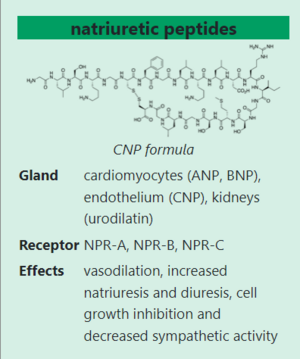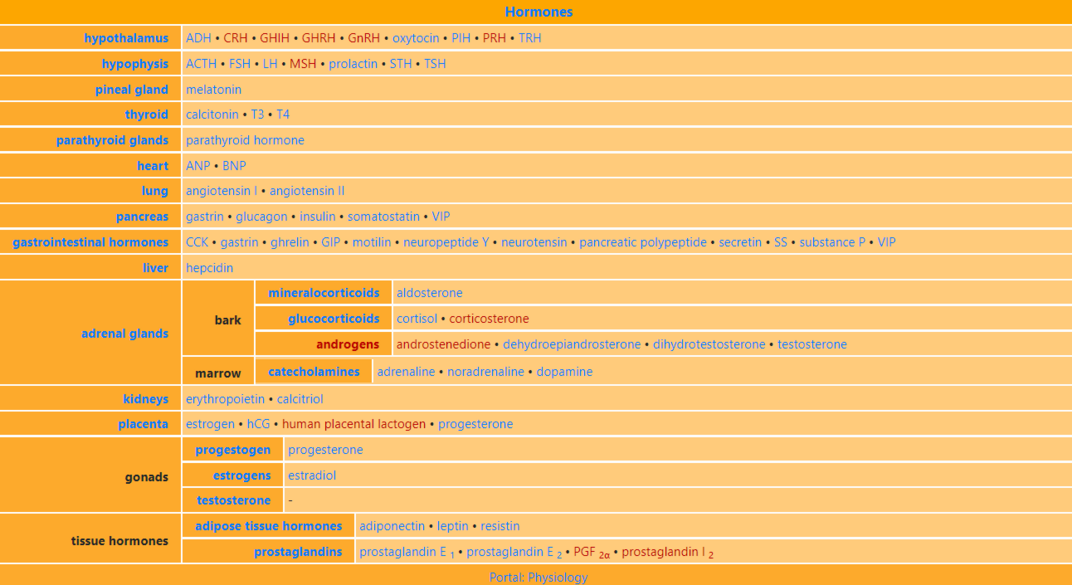Natriuretic peptides
ANP:
Heart failure and heart failure are associated with pathological activation of neurohumoral mechanisms (especially the renin-angiotensin-aldosterone - RAAS axis ), which lead to sodium and water retention, vasoconstriction, pathological cell growth and cardiac fibrosis, thereby potentiating the progression of heart failure. The physiological antimechanism of such pathological activation of the renin-angiotensin-aldosterone axis is the natriuretic peptide system . Natriuretic peptides have a vasodilating effect, increase natriuresis and diuresis , inhibit cell growth and reduce sympathetic activity. [1] [2]
Shortcuts[edit | edit source]
We currently distinguish 4 natriuretic peptides. They are :
- Natriuretic peptide A (ANP, atrial natriuretic peptide). ANP is secreted by atrial cardiomyocytes in the form of prohormone (pro-ANP), which consists of 126 amino acids and which is cleaved into 2 fragments - the ANP itself (biologically active, consisting of 28 amino acids) and the N-terminal fragment (N-BNP, biologically inactive ). The stimulus for ANP secretion is increased tension in the atrial wall
- Natriuretic peptide B (BNP, brain natriuretic peptide, brain natriuretic peptide ). It was first described in the pig's brain (hence its name). In humans, it is secreted primarily by ventricular cardiomycytes , in response to increased ventricular wall tension or ventricular myocardial dilatation. It is also secreted in the form of a prohormone (pro-BNP, 108 amino acids) and cleaved into 2 fragments - the BNP itself (biologically active) and the N-terminal fragment (NT-proBNP, biologically inactive)
- Natriuretic peptide C (CNP). CNP is secreted by the vascular endothelium in response to endothelial stress
- Urodilatin .
The secretion of ANP and BNP by cardiomyocytes occurs during pressure and volume overload of the heart. Peptides enter the bloodstream and bind to specific receptors (NPR-A, NPR-B, NPR-C) on the surface of target cells. The labeling of individual receptors does not express their selective affinity for individual receptors
Indications[edit | edit source]
The determination of BNP or its N-terminal fraction (NT-proBNP) is used in 2 main indications:
- to rule out heart failure in a suddenly suffocating patient
- to determine the prognosis of a patient with heart failure
Laboratory values[edit | edit source]
| Chronic heart failure | Acute heart failure | |
|---|---|---|
| BNP | > 100 pg / ml | > 500 pg / ml |
| NT-proBNP | > 125 pg / ml | > 1,800 pg / ml |
| in younger people > 450 pg / ml |
Interpretation of BNP values by age[edit | edit source]
According to: Akutne.cz
| Acute heart failure ruled out | Acute heart failure highly likely | |
|---|---|---|
| up to 50 years | less than 300 pg / ml | > 450 pg / ml |
| 50-75 years | less than 300 pg / ml | > 900 pg / ml |
| over 75 years | less than 300 pg / ml | > 1,800 pg / ml |
Links[edit | edit source]
Related articles
Reference[edit | edit source]


